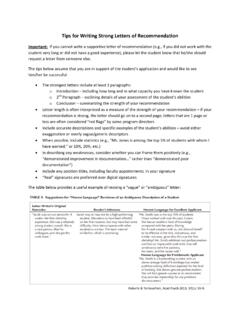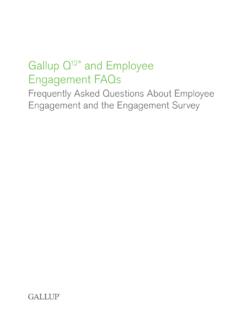Transcription of The Mark of a Criminal Record1 - Harvard University
1 AJSV olume 108 Number 5 (March 2003): 937 75937 2003 by The < strong >Universitystrong > of Chicago. All rights $ Mark of a < strong >Criminalstrong > < strong >Record1strong > Devah PagerNorthwestern UniversityWith over 2 million individuals currently incarcerated, and overhalf a million prisoners released each year, the large and growingnumber of men being processed through the < strong >Criminalstrong > justice systemraises important questions about the consequences of this massiveinstitutional intervention. This article focuses on the consequencesof incarceration for the employment outcomes of black and whitejob seekers. The present study adopts an experimental auditapproach in which matched pairs of individuals applied for realentry-level jobs to formally test the degree to which a < strong >Criminalstrong > re-cord affects subsequent employment opportunities. The findings ofthis study reveal an important, and much underrecognized, mech-anism of stratification.
2 A < strong >Criminalstrong > record presents a major barrierto employment, with important implications for racial stratification researchers typically focus on schools, labor markets,and the family as primary institutions affecting inequality, a new insti-tution has emerged as central to the sorting and stratifying of young anddisadvantaged men: the < strong >Criminalstrong > justice system. With over 2 million in-dividuals currently incarcerated, and over half a million prisoners releasedeach year, the large and growing numbers of men being processed throughthe < strong >Criminalstrong > justice system raises important questions about the conse-quences of this massive institutional article focuses on the consequences of incarceration for the em-1 Support for this research includes grants from the National Science Foundation (SES-0101236), the National Institute of Justice (2002-IJ-CX-0002), the Joyce Foundation,and the Soros Foundation.
3 Views expressed in this document are my own and do notnecessarily represent those of the granting agencies. I am grateful for comments andsuggestions from Marc Bendick, Jr., Robert M. Hauser, Erik Olin Wright, LincolnQuillian, David B. Grusky, Eric Grodsky, Chet Pager, Irving Piliavin, Jeremy Freese,and Bruce Western. This research would not < strong >havestrong > been possible without the supportand hospitality of the staff at the Benedict Center and at the Department of Sociologyat the < strong >Universitystrong > of Wisconsin Milwaukee. Direct correspondence to Devah Pager,Department of Sociology, Northwestern < strong >Universitystrong > , 1810 Chicago Avenue, Evanston,Illinois 60208. E-mail: Journal of Sociology938ployment outcomes of black and white men. While previous survey re-search has demonstrated a strongassociationbetween incarceration andemployment, there remains little understanding of the mechanisms bywhich these outcomes are produced.
4 In the present study, I adopt anexperimental audit approach to formally test the degree to which a crim-inal record affects subsequent employment opportunities. By usingmatched pairs of individuals to apply for real entry-level jobs, it becomespossible to directly measure the extent to which a < strong >Criminalstrong > record in theabsence of other disqualifying characteristics serves as a barrier to em-ployment among equally qualified applicants. Further, by varying therace of the tester pairs, we can assess the ways in which the effects ofrace and < strong >Criminalstrong > record interact to produce new forms of labor IN INCARCERATIONOver the past three decades, the number of prison inmates in the UnitedStates has increased by more than 600%, leaving it the country with thehighest incarceration rate in the world (Bureau of Justice Statistics 2002a;Barclay, Tavares, and Siddique 2001).
5 During this time, incarceration haschanged from a punishment reserved primarily for the most heinous of-fenders to one extended to a much greater range of crimes and a muchlarger segment of the population. Recent trends in crime policy < strong >havestrong > ledto the imposition of harsher sentences for a wider range of offenses, thuscasting an ever-widening net of penal the recent tough on crime policies may be effective in gettingcriminals off the streets, little provision has been made for when they getback out. Of the nearly 2 million individuals currently incarcerated,roughly 95% will be released, with more than half a million being releasedeach year (Slevin 2000). According to one estimate, there are currentlyover 12 million ex-felons in the United States, representing roughly 8%of the working-age population (Uggen, Thompson, and Manza 2000). Ofthose recently released, nearly two-thirds will be charged with new crimesand over 40% will return to prison within three years (Bureau of JusticeStatistics 2000).
6 Certainly some of these outcomes are the result of desolateopportunities or deeply ingrained dispositions, grown out of broken fam-2 For example, the recent adoption of mandatory sentencing laws, most often used fordrug offenses, removes discretion from the sentencing judge to consider the range offactors pertaining to the individual and the offense that would normally be taken intoaccount. As a result, the chances of receiving a state prison term after being arrestedfor a drug offense rose by 547% between 1980 and 1992 (Bureau of Justice Statistics1995). < strong >Criminalstrong > Record939ilies, poor neighborhoods, and little social control (Sampson and Laub1993; Wilson 1997). But net of these contributing factors, there is evidencethat experience with the < strong >Criminalstrong > justice system in itself has adverse con-sequences for subsequent opportunities. In particular, incarceration is as-sociated with limited future employment opportunities and earnings po-tential (Freeman 1987; Western 2002), which themselves are among thestrongest predictors of recidivism (Shover 1996; Sampson and Laub 1993;Uggen 2000).
7 The expansion of the prison population has been particularly conse-quential for blacks. The incarceration rate for young black men in theyear 2000 was nearly 10%, compared to just over 1% for white men inthe same age group (Bureau of Justice Statistics 2001). Young black mentoday < strong >havestrong > a 28% likelihood of incarceration during their lifetime (Bureauof Justice Statistics 1997), a figure that rises above 50% among youngblack high school dropouts (Pettit and Western 2001). These vast numbersof inmates translate into a large and increasing population of black ex-offenders returning to communities and searching for work. The barriersthese men face in reaching economic self-sufficiency are compounded bythe stigma of minority status and < strong >Criminalstrong > record. The consequences ofsuch trends for widening racial disparities are potentially profound (seeWestern and Pettit 1999; Freeman and Holzer 1986).
8 PRIOR RESEARCHW hile little research to date has focused on the consequences of criminalsanctions, a small and growing body of evidence suggests that contactwith the < strong >Criminalstrong > justice system can lead to a substantial reduction ineconomic opportunities. Using longitudinal survey data, researchers havestudied the employment probabilities and income of individuals afterrelease from prison and < strong >havestrong > found < strong >a strongstrong > and consistent negative effectof incarceration (Western and Beckett 1999; Freeman 1987; Nagin andWaldfogel 1993).This existing research has been instrumental in demonstrating the pos-sible aggregate effects of incarceration on labor market outcomes. Un-fortunately, however, there are several fundamental limitations of surveydata that leave the conclusions of this research vulnerable to harsh crit-icism. First, it is difficult, using survey data, to rule out the possibilitythat unmeasured differences between those who are and are not convictedof crimes may drive the observed results.
9 Figure 1 presents one possiblemodel of the relationship between incarceration and employment out-comes, with a direct causal link between the two. In this model, an in-dividual acquires a < strong >Criminalstrong > record, which then severely limits his laterAmerican Journal of Model of direct causationemployment opportunities. But what evidence can we offer in support ofthis causal relationship? We know that the population of inmates is nota random sample of the overall population. What if, then, the poor out-comes of ex-offenders are merely the result of preexisting traits that makethese men bad employees in the first place? Figure 2 presents a model ofspurious association in which there is no direct link between incarcerationand employment outcomes. Instead, there are direct links between variouspreexisting individual characteristics ( , drug and alcohol abuse, be-havioral problems, poor interpersonal skills), which increase the likelihoodof both incarceration and poor employment this model, theassociation between incarceration and employment is entirely spuri-ous the result of individual predispositions toward with figure 2, Kling (1999), Grogger (1995), and Needels(1996) < strong >havestrong > each argued that the effect of incarceration on employmentis negligible, at an estimated 0% 4%.
10 Using administrative data fromunemployment insurance (UI) files matched with records from variousstate departments of corrections, these authors contend that the observedassociation is instead largely determined by unmeasured individual findings of these authors stand in stark contrast to themajority of literature asserting < strong >a strongstrong > link between incarceration andemployment (Western and Beckett 1999; Bushway 1998; Sampson andLaub 1993; Freeman 1987; Grogger 1992). While it remains an openquestion as to whether and to what extent incarceration causes employ-3 The variables listed here are just a few of the many potential sources of spuriousnessthat are virtually untestable using survey using administrative data < strong >havestrong > the advantage of analyzing large samples ofex-offenders over extended periods of time, before and after incarceration.
















